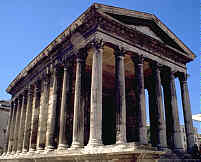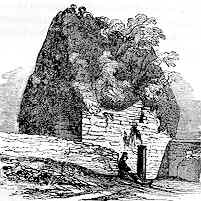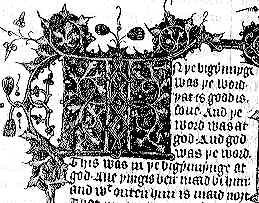




If you are looking at this page without frames, there is more information about medieval writing to be found by going to the home page (framed) or the site map (no frames).
| Latin | ||||||
| Latin was established as the language of bureaucracy and as the language of the western church during the Roman epoch. It was the only language written universally across western Europe and the only language with a standardised grammar and spelling. It is therefore hardly surprising that it should become the fundamental language of the re-emergence of literacy after the end of the Roman Empire. The earliest scripts used were derived directly from those of the Roman era. |
 |
|||||
| The Roman temple at Nimes in southern France. Roman architecture across Europe also symbolises Roman law, culture and the Latin language. | ||||||
 |
Early Christian writings were in Greek, Hebrew and Latin, but Latin was established as the language of the western church. The religious works carried by missionary monks across Europe were in Latin. As these communities became the focus for developing literacy in the regions, the use of Latin extended into other areas, including government. | |||||
| Remains of the ancient monastery of Kells in Ireland, fount of literacy. | ||||||
| Vernacular languages were highly variable, consisting of collections of dialects which might be incomprehensible over even a small geographical range. Latin provided a structured language of government which could be comprehended across all dialect boundaries. | ||||||
| As writings by scholars all over Europe were added to the growing corpus of literary works being transcribed and placed in libraries, they were produced in the language which could be read by scholars everywhere. Despite slowness of transport and difficulties of communication, Latin literacy defined a subset of society scattered across many countries. The international community of scholars did not require the jet engine to function, simply a common language of communication. | ||||||
| Medieval Latin has some idiosyncracies which differentiate it from Classical Latin. Latin was not a “dead” language in the medieval era, as is sometimes asserted, but it was largely a written rather than a spoken language. It was declaimed aloud during church liturgy, but not generally used in conversation, except presumably among scholars. Some grammatical forms became simplified. New vocabulary was introduced to cope with new concepts that never needed to be expressed in the Classical language, as happens in every living and evolving language. Some eccentric forms developed. There are substantial dictionaries of medieval Latin words which are not found in the original language. |
 |
|||||
| Latin was the language of the medieval mass, as depicted in this tableau in Gloucester Cathedral. | ||||||
| See Martin 1976 or Latham 1965 or investigate the numerous web resources for tackling various aspects of medieval Latin. Check our ever expanding Links section for details. | ||||||
 |
In the absence of an appropriate Latin word, vernacular words may be inserted abruptly into a Latin text. This may be because they are legal terms relating to known concepts in a vernacular oral tradition, or simply because the writer did not know an appropriate Latin word. I am reliably informed that “le wheelbarrow” and “le strawberry” have both been detected in Latin monastic accounts. | |||||
| Language represents power, and it is undoubtedly the case that the bureacracy of the Christian church retained Latin for all its rituals and its writings in order to keep control of thought within the preserve of the literate clergy. The laity, not versed in the language, could not scrutinise or question the fundamental texts or the commentaries of scholars directly. They relied on the oral teachings of the clergy. | ||||||
| Periodic assaults on the use of vernacular languages in a religious context coincided with the suppression of heresy or the imposition of orthodoxy. The Gothic Bibles of Theoderic the Ostrogoth were destroyed and scraped down because they were associated with the Arian heresy. The reform of Benedictine monasticism in England in the 10th century was followed by a return to Latin rather than Old English texts, a process enhanced by the effects of the Norman conquest of England. Irish vernacular texts disappeared from the church with monastic reforms. The vernacular Bibles of the Lollards were banned. Latin was sacred, but also exclusive and an instrument of power. | ||||||
 |
||||||
| An English language Lollard Bible. | ||||||
| In the earlier centuries of the middle ages, Latin was the official language of the church, of law, of knowledge and of literature. While vernacular languages invaded the areas of literature, law and business, Latin remained the language of the church. Not only was all liturgy conducted in Latin, it was the language of learning and the language of conduct of official church affairs. It was the language of solemnity and ritual. It remained the language of the universities and international scholarship. | ||||||
|
|
||||||
|
|
||||||
|
If you are looking at this page without frames, there is more information about medieval writing to be found by going to the home page (framed) or the site map (no frames). |
||||||